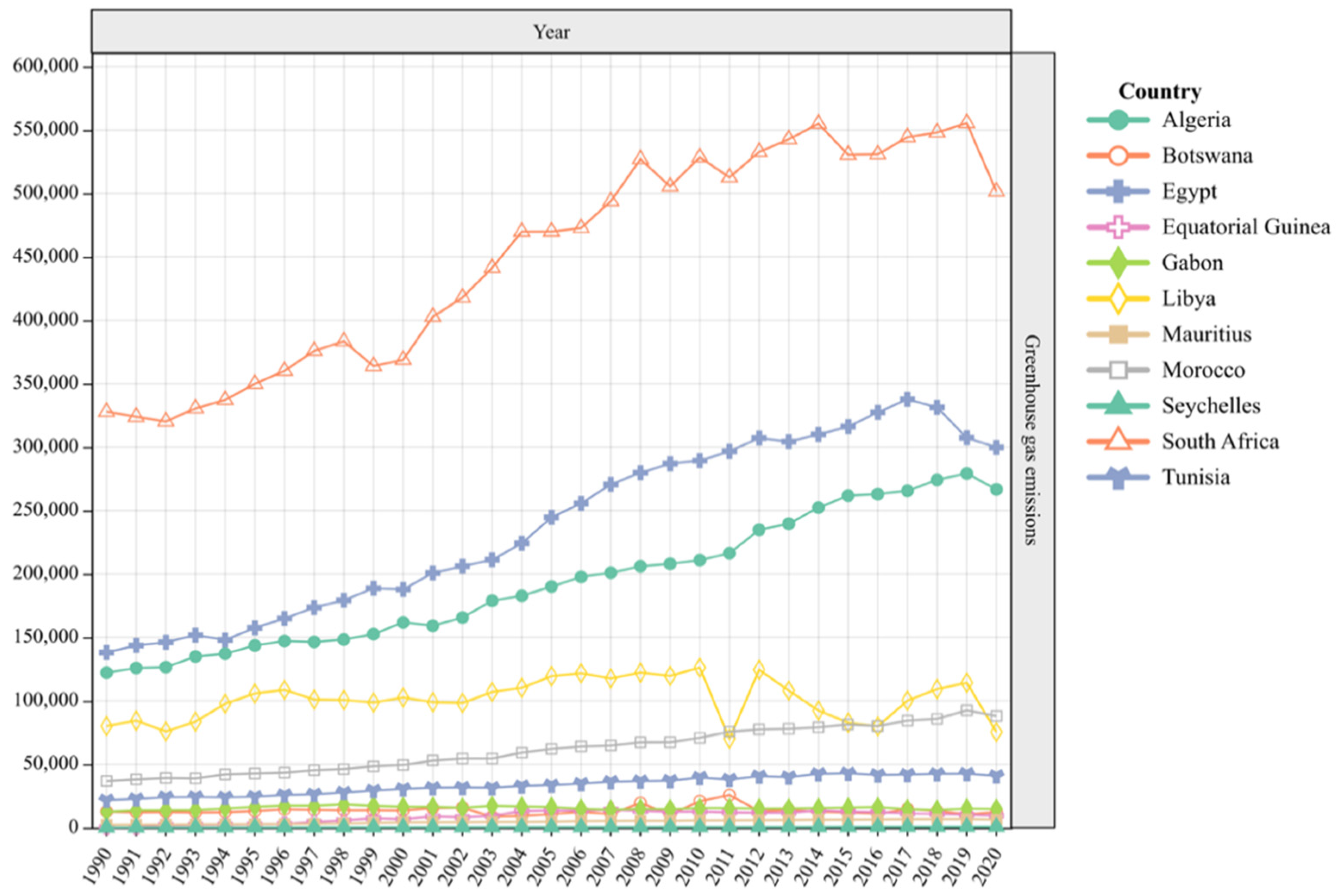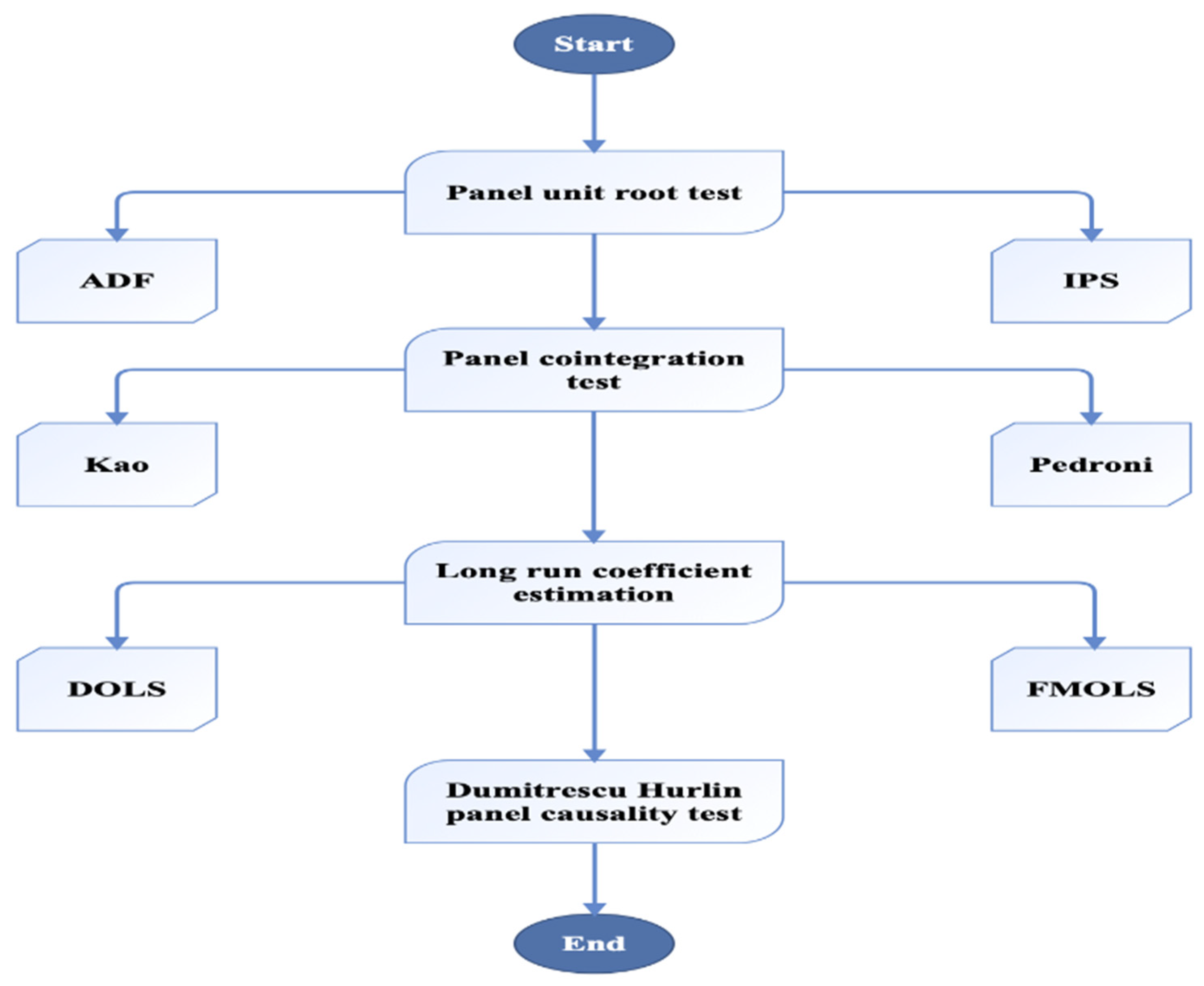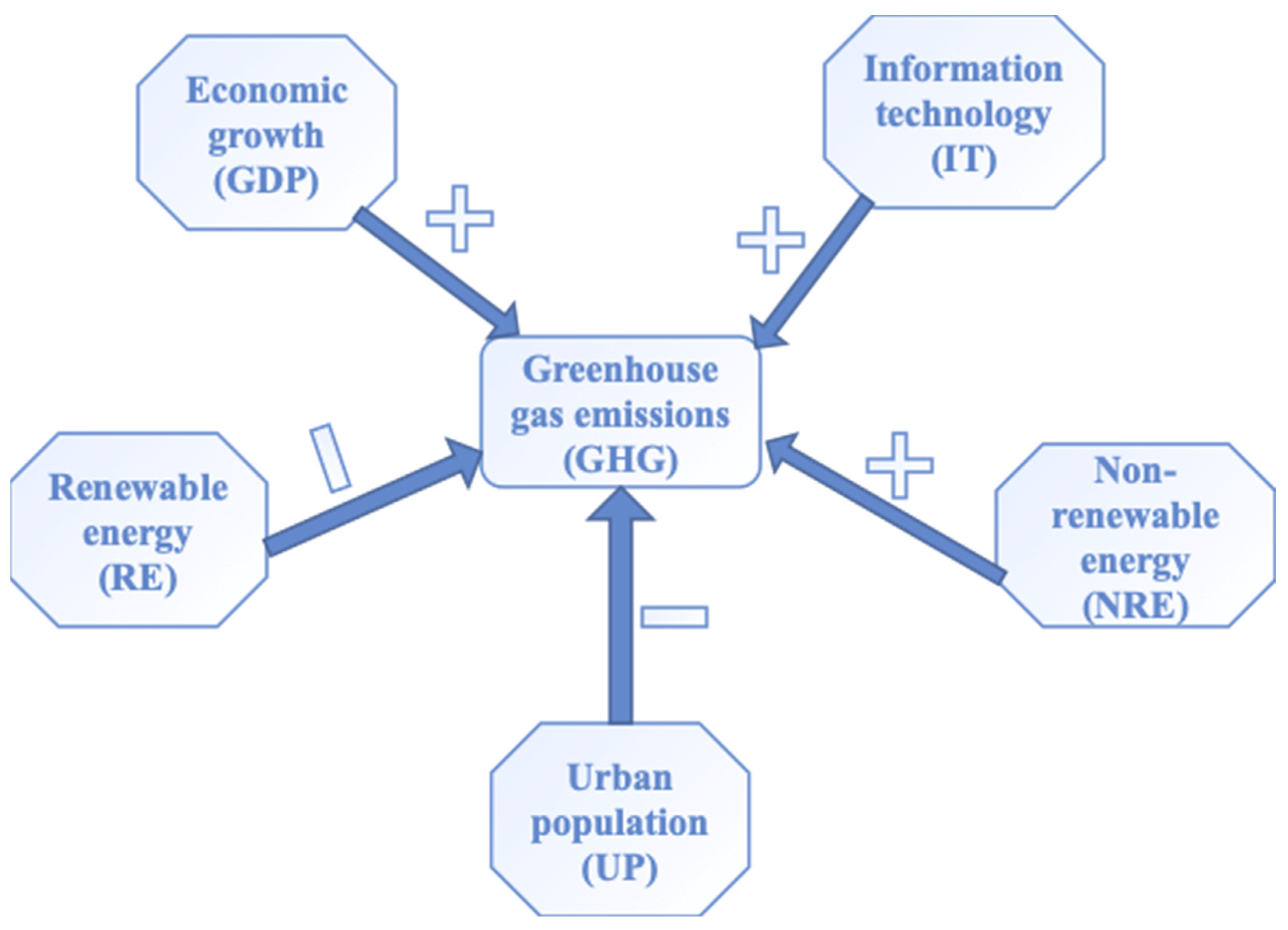1. Introduction
Greenhouse gas emissions (GHG) have risen in the last two decades due to several reasons. Its constituents include carbon dioxide, methane, and nitrous oxide emissions from all sources, including agriculture and land use change. The most significant greenhouse gas is carbon dioxide. Researchers measure greenhouse gas emissions in “carbon dioxide-equivalents” (CO
2eq) to account for all emissions. This accounts for all greenhouse gases, not just CO
2. Various studies have used CO
2 to measure environmental pollution. However, this study uses GHG because it intends to measure the impact of the chosen variables on the overall ecological pollutants, not just CO
2, as seen in many studies. In the climate change space, significant policies that have been encouraged and advised in recent years to reduce greenhouse gas (GHG) emissions have focused on enhancing clean energy [
1,
2]. The primary drivers of these policies are the extreme levels of CO
2 emissions triggered by intensive non-renewable energy (NRE) in the overall energy mix [
3,
4]. Over 80% of the energy consumed worldwide comes from non-renewable sources [
5]. This larger share has continued to worsen the dire issues associated with environmental pollution [
6,
7].
The problem is worse for developing countries like Africa, which rely on fossil fuel consumption and have relatively lower technological advancement [
8]. For the green energy transition, mitigating climate change and its effects is desirable [
9,
10]. In this quest, scholars and decision-makers have recently debated the subject. Two crucial initiatives have been mentioned throughout the conversation as having a greater chance of reducing the rise in CO
2 emissions. Green energy promotion comes first, followed by the growth of information and communication technology (ICT) [
1]. In addition to benefitting the environment, renewable energy (RE) sources have become a viable alternative to conventional energy sources. These benefits also have a positive effect on the economy [
11]. At least 0.4 billion tonnes of CO
2 emissions can be reduced by transitioning to cleaner or green energies [
5]. Moreover, technological advancement is essential for GHG emissions to be lowered in a sustainable manner [
12]. Economies can realize the twin goals of developing their economy and environmental sustainability through technological improvement [
9]. Globally, information and communications technology (ICT) contributes 1.5 gigatons, which represents approximately 2% of the world’s (GHG) emissions annually [
13]. The industry has also contributed enormously towards environmental sustainability. Technologies aimed at improving ecological sustainability have significantly reduced GHGs in various sectors. In this regard, the ICT industry plays a more critical role in the fight against climate change. The industry is already working to reduce various types of emissions through technological innovation. As a result, its significant role in the GHG space within the African context should be analysed corresponding to its efficient energy use.
Fossil fuel energy (mostly coal) has contributed to significant GHG emissions over the ensuing years to meet the energy needs of developing nations like those in Africa [
14]. As one of the developing regions, Africa contributed 3.9% of CO
2 emissions worldwide from industry and fossil fuels in 2021 [
15]. The continent added the smallest amount of GHG gases to the total emissions globally over the past two decades, varying between 3.4% and 3.9% [
15]. Until recently, studies examining the causes of CO
2 emissions and energy consumption have not focused on Africa due to its comparatively modest contribution to global carbon emissions [
9,
16]. However, it is worth noting that CO
2 emissions in the area have significantly increased recently, with an average rise of 15.48% between 1995 and 2017 [
9]. On the other hand, African economies have been growing tremendously in the last decade compared to the previous due to trade openness, foreign direct investment, technological advancement, and population growth. For example, Ghana was the fastest-growing economy in the world in 2019 [
17]. With this rapid growth, it is evident that if measures are not put in place, Africa’s growth will lead to increased pollution, as seen in advanced countries like China and the United States, because economic growth has been associated with pollution problems [
8]. According to the World Bank, Libya and Botswana are among the top GHG emitters in Africa, but have the fastest and highest rates of economic growth in Africa of 31.37% and 11.36%, respectively [
18]. Unfortunately, although some countries produce more CO
2 emissions than others, the consequences affect almost every region and the world. For instance, coal, which includes up to 45% ash and 1.2% sulphur, produces more than 90% of the energy in South Africa [
19]. Also, the population has been argued as one of the significant influencers of GHG emissions. Countries with a higher population or urban population density will likely contribute to environmental pollution. These assertions and evidence led to the selection of variables to aid the study. The top polluting countries have been investigated in this study because it is necessary to identify mitigating factors to curb emissions, which will benefit the polluters and the innocent countries that emit insignificant amounts of GHG. Without proper climate change policy in place, Ref. [
20] predicted that by 2100, Africa might contribute 5–20% of the world’s CO
2 emissions. Without effective mitigation measures, the anticipated trends in CO
2 emissions will cause a catastrophic situation for African countries, where most of them are destitute. This problem is emerging and spreading throughout Africa and other parts of the world.
Considering the above problem, it is imperative to conduct research that assesses the specific impact of energy consumption, I.T., economic growth, and population using Top GHG-emitting countries of the continent. In addition, Africa must immediately consider strategies to reduce or stop any potential increases in atmospheric GHG emissions [
21]. This article addresses this critical question using top GHG-emitting countries in the region. Green energy sources like wind, solar, and hydropower can help Africa thrive in an environmentally friendly way. Africa has access to various renewable energy sources [
22]. Despite being unlimited and freely available in the area, these renewable energies are mostly underdeveloped compared to non-renewable energy, emphasizing the important role of technological implementation in the region’s transition to a greener economy. Thus, the main focus of this study is to highlight the role green energy and I.T. can play in developing Africa’s sustainability. Specifically, the objectives of this research are to: (1) Determine the role of renewable energy on GHG emissions, (2) Determine the influence of non-renewable energy on GHG emissions in top GHG-emitting countries in Africa, (3) Determine the role played by economic growth in top GHG-emitting countries in Africa, (4) Establish the impact of urban population on top GHG-emitting African countries. Compared with earlier studies, this work’s novelty is threefold, and will make the following contributions to the literature and policymakers. First, this study is one of the first to examine how using green energy affects GHG emissions in the top African emitters of GHG gases, according to the latest data from [
15]. Most nations have high-energy needs and significant possibilities for generating RE; analysing these top GHG-producing regions as a research case is particularly fascinating. Second, most of the studies conducted in Africa considered all countries, sub-Saharan Africa (SSA) or randomly selected countries, which may have generalizability issues. Some countries produce more GHG emissions than others, and thus placing them within the same category may create an unreliable result. This study considers the top 11 (T-11) GHG emitters in Africa to measure the real impact of these variables on others. This will provide more robust results. Lastly, this study adds to the environmental literature by investigating the influence of information technology on the GHG emissions of top GHG-emitting countries in Africa. By filling these gaps, the study will significantly contribute to the body of literature and suggest meaningful and practical policy implications that will help top GHG-emitting countries reduce pollution and assist low GHG-emitting countries in guiding their way through environmental sustainability as their economy grows. It will provide a strong foundation for future studies that intend to investigate the relationship between energy structures and environmental pollution in Africa and around the globe. The policy implications suggested in this study will equip policymakers with the information necessary to provide great policies to enhance green energy usage. Policymakers will identify the areas that need support and channel resources to promote environmental sustainability and meet energy needs.
5. Conclusions and Policy Implications
5.1. Conclusions
This study provides an in-depth examination into the role of energy structures on environmental pollution in Africa. Specifically, the study examines the impact of RE, NRE, and I.T. on GHG emissions using T-11 GHG-emitting countries in Africa from 1990–2020. This study further investigates the effects of economic growth and urban population on greenhouse gas emissions. To examine the impact of selected factors on GHG emissions for the T-11 GHG countries in Africa, this paper applies panel co-integration, i.e., Pedroni and Kao. Similarly, DOLS and FMOLS estimation are used to examine the long-run associations of the explanatory variables. In addition, this study adopts the D-H panel causality test to test the causal association between variables. The empirical results indicate that non-renewable energy boosts greenhouse gas emissions in T-11 GHG African countries. The finding indicates that the urban population decreases the degree of GHG emissions in the long run. Therefore, in the case of T-11 emissions countries, their urban areas tend to have higher energy consumption per capita than rural areas. The finding reveals that RE reduces the degree of GHG emissions in the long run. Again, the study found that information technology causes GHG emissions to rise in T-11 GHG-emitting African countries. Lastly, the finding shows that GDP increases GHG emissions. Based on the D-H panel causality test, the study shows bi-directional causality between GDP and GHG emissions in T-11 GHG African countries. The finding also indicates bidirectional causality between I.T. and GHG emissions, with corresponding feedback from GHG emissions to I.T. Again, a bidirectional causal link was identified between GHG emissions and RE, with related feedback from GHG emissions to RE. Finally, the study discovers a bidirectional causality between NRE and GHG emissions, with corresponding feedback from GHG emissions to NRE. Based on these findings, this study proposes the following policy implications.
5.2. Managerial Policy Implications/Recommendations
To begin with, the results indicated that non-renewable energy performs well in boosting greenhouse gas emissions in T-11 GHG African countries. The study recommends that policymakers in these countries focus on achieving a diversified energy mix and transitioning to cleaner and renewable energy sources. This may include promoting research and development of renewable energy technologies, encouraging investment in renewable energy infrastructure, and setting targets for renewable energy consumption. Governments in these countries should implement stricter regulations and enforce emission reduction targets for industries that rely heavily on non-renewable energy sources. This could include setting limits on GHG emissions and imposing penalties for non-compliance.
Again, it is recommended that policymakers in these nations seek to facilitate the transition from NRE to RE sources in a way that considers the economic impact. This may include creating job training programs for workers in non-renewable energy industries to transition to clean energy sectors and providing financial support to communities that rely heavily on non-renewable energy.
Moreover, the finding reveals that renewable energy decreases the degree of GHG emissions in the long run. Policymakers in these countries should prioritize the development of renewable energy sources by establishing supportive policies and programs. These may include incentives for investment in renewable technologies, the establishment of funds to support research and development, and the provision of financial incentives for adopting RE sources.
In addition, the study recommends that policymakers in these countries must develop and/or strengthen regulatory frameworks to support the transition to renewable energy. Governments must establish policies that incentivize a shift toward renewable energy and discourage conventional power generation. This may include setting emission limits, ensuring compliance, and rigorously enforcing renewable energy targets. Policymakers in these countries should prioritize educating the public about the benefits of renewable energy and reducing greenhouse gas emissions. Public awareness campaigns, energy-efficiency programs, and school education to promote sustainable and clean energy sources are great avenues. The need to encourage and support innovation in renewable energy technologies must be prioritized in these countries. R&D efforts should focus on improving the efficiency and effectiveness of RE sources, as highlighted in the studies of [
101,
102,
103,
104]. Green innovation can eradicate the energy crisis, which eventually affects GHG. This may include researching and promoting fuel cells, solar power generation, wind, and wave power.
Lastly, the study found that information technology increases GHG emissions in T-11 GHG-emitting African countries. Governments of these countries should foster the use of sustainable practices and policies among information technology companies by implementing programs such as recycling, refurbishing, and disposing of electronic equipment. In this quest, funding for research and development to enhance the use of green technology must be provided. This may include research into new technological solutions to reduce GHG emissions associated with information technology, such as IoT technologies that help monitor and conserve energy. This study recommends that policymakers promote international cooperation and collaboration to develop standards and policies that reduce technology-related GHG emissions.









